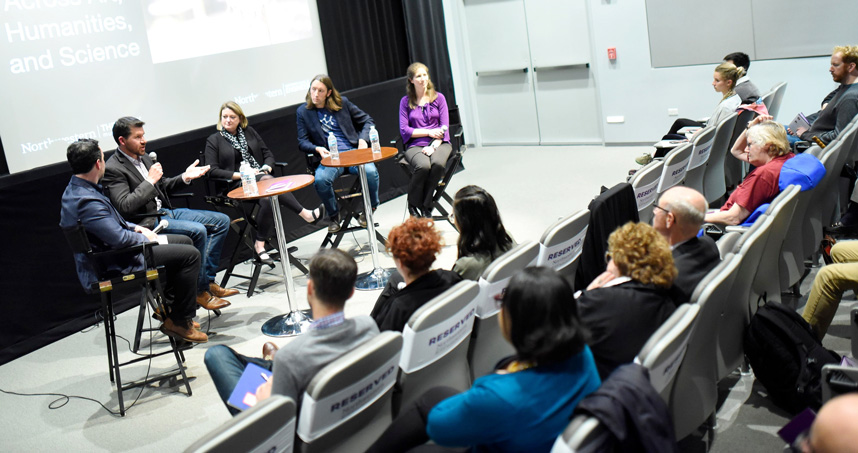Exploring the Ethics of Emerging Science
“Exploring Ethics: Across Art, Humanities, and Science” was held on May 8 at The Block Museum
From new ways to fight disease to managing natural resources, scientists working at the forefront of technological innovation are driven to profoundly influence life as we know it. Yet coinciding with the arrival of these new advances are ethical questions that consider the foreseen — and unforeseen — impact these technologies could have on individual relationships, communities, and society.
How do ethical considerations impact decisions that scientists and researchers make every day? How can engineers adapt science to social needs? What is the public’s role in technologies that redefine fundamental aspects of life itself?
Those questions guided “Exploring Ethics: Across Art, Humanities, and Science,” a public forum held on May 8 at The Block Museum of Art. Sponsored by the McCormick School of Engineering and The Block Museum, the event brought together engineers, artists, and researchers from Northwestern to discuss how leaders in science and the humanities are raising new ethical questions emerging from innovative scientific research.
Tackling Complex Problems with Engineering + Art
Transdisciplinary artist Dario Robleto guided the evening’s discussion. With a deep appreciation for science, Robleto perceives a growing gap between public awareness and scientific developments, one he feels is contributing to a lack of ethical oversight in scientific innovation. He said working across disciplines is vital to fostering a conversation that leads to new levels of moral understanding.
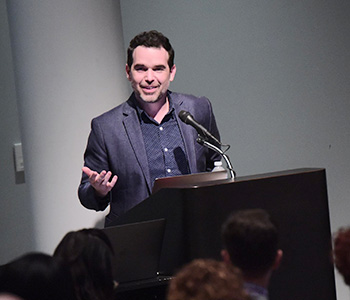 “Increasingly, our investigations into life and existence are just so complex that I argue many have transcended their field of origin,” Robleto said. “There’s no way of understanding them unless you have multiple disciplines on the problem.”
“Increasingly, our investigations into life and existence are just so complex that I argue many have transcended their field of origin,” Robleto said. “There’s no way of understanding them unless you have multiple disciplines on the problem.”
For the last two years, Robleto has served as Northwestern’s inaugural artist-at-large, an initiative between Northwestern Engineering and The Block Museum to bring an artistic perspective to topics in computer science, design, and climate change. In his role, Robleto connected with faculty in Northwestern’s Center for Synthetic Biology and Center for Bioethics and Medical Humanities to explore how life-changing technologies in development are balanced with consideration over the ethical and societal impact of the work.
“What I have been drawn to working with my colleagues is that, they are not only operating within known ethical frameworks, but they are also inventing new ethical problems that we don’t have the answers to,” Robleto said. “That’s a different ballgame with different rules.”
Using Art to Uphold Ethical Standards
Robleto also shared how ethical dilemmas have impacted his own experience as an artist. While working with a glaciologist at Waterton-Glacier International Peace Park in Alberta, he learned that the melting of the Park’s glaciers had unearthed large remains of prehistoric mammals, tens of thousands of years old. The melting trend has given rise of a new trade market in the region — woolly mammoth bones.
Robleto wondered if there was a more appropriate response.
“If humans pushed an animal to extinction, do we not have the moral obligation to bring them back if we have the tech to do it?” Robleto said. “That’s a very controversial idea that deserves to be publicly debated and pushed back on.”
The debate led Robleto to create Some Longings Survive Death, an artistic piece that commemorates the death of a previously frozen woolly mammoth by presenting its hair, tusks, ivory using 19th century mourning traditions.
“We didn’t yet have the ethical standards to be hard on ourselves with that first wave of mass extinction,” Robleto said. “We didn’t have culture, the visual and material vocabulary to mourn, but over time, humans have developed the ethical questions and responses through art to deal with very problematic things in our past.”
The ‘Dual-use’ of Synthetic Biology
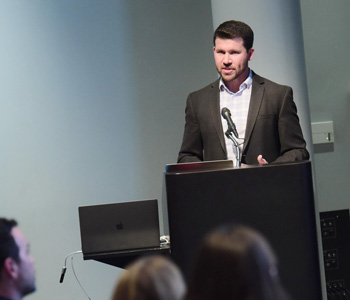 Josh Leonard, one of three speakers from the Center for Synthetic Biology, expanded on the promise of the growing field — and the ethical considerations that coincide with it. By reprogramming cells at the DNA-level, synthetic biologists are developing new ways to create targeted therapeutics or next-generation materials or chemicals.
Josh Leonard, one of three speakers from the Center for Synthetic Biology, expanded on the promise of the growing field — and the ethical considerations that coincide with it. By reprogramming cells at the DNA-level, synthetic biologists are developing new ways to create targeted therapeutics or next-generation materials or chemicals.
“Whether you’re talking about a biological system as a collection of molecules, a cell, or an entire organism, we’re trying to figure out the design rules, the parts, even the philosophical ways to go about doing this,” said Leonard, associate professor of chemical and biological engineering.
Leonard explained that many ethical considerations in synthetic biology stem from the “dual-use” nature of the field. He noted, for example, that synthetic biologists can now create fully synthetic viruses from scratch. While such capability “sounds scary,” he showcased a model specifically designed to respond to pandemic influenza within a week.
“These are the challenges we wrestle with all the time when we’re deciding how to move forward with a technology,” Leonard said.
The Consequences of Clean Water
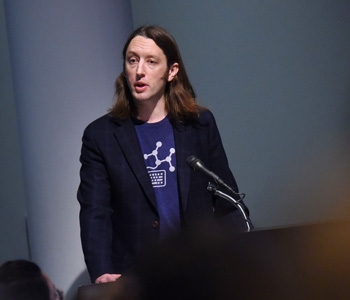 For Julius Lucks, associate professor of chemical and biological engineering, scientists and artists travel a similar path to discover, analyze, and communicate the world around them, a mindset that has informed his work tackling a growing public concern — clean water.
For Julius Lucks, associate professor of chemical and biological engineering, scientists and artists travel a similar path to discover, analyze, and communicate the world around them, a mindset that has informed his work tackling a growing public concern — clean water.
A member of Northwestern’s Center for Water Research, Lucks and his lab are working to develop a small, fast, inexpensive water quality monitor using advances in cell-free synthetic biology and molecular engineering to sense contaminates.
While Lucks’s technology could help empower countless people, discussions with Robleto revealed thought-provoking consequences: If anyone could test the health of their water, for example, how might that impact trust in, and provoke action toward, their local governments?
“This is a very real possibility,” Lucks said. “As scientists, it’s unanticipated. We didn’t think we would face these questions when we first started this project.”
Technology to Benefit the Common Good
Unanticipated consequences were also at the heart of Danielle Tullman-Ercek’s talk, which discussed how to ensure technological advances reach those who need them most. An expert in engineering microbes, like bacteria, she is using synthetic biology strategies to create new ways to produce proteins — a pivotal component of therapeutics, cleaning supplies, and materials — more efficiently.
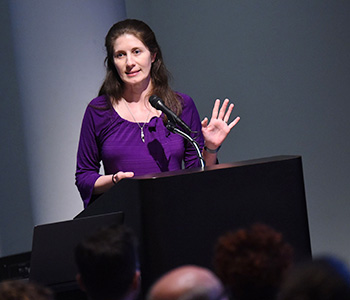 One such technology, a novel protein secretion pump created in her lab, achieved a 20-fold increase in the amount of protein that could be made with bacteria. It marked a breakthrough that could dramatically reduce the cost of medicines like insulin, impacting countless lives.
One such technology, a novel protein secretion pump created in her lab, achieved a 20-fold increase in the amount of protein that could be made with bacteria. It marked a breakthrough that could dramatically reduce the cost of medicines like insulin, impacting countless lives.
“We made this wonderful thing, but how do we do make people aware of it so it can be used to make proteins more efficiently for the common good?” said Tullman-Ercek, associate professor of chemical and biological engineering.
Tullman-Ercek and her team shared the research with the world, making the technology freely available online. After presenting the work at an industry conference, she received immediate interest from companies interested in licensing the technology — until they heard the work was open source. Without a patent, companies were unwilling to invest in technology they didn’t own the rights to. “The outcome was the exact opposite of what we intended,” she said.
“There are solutions using the system we have, but they are workarounds,” Tullman-Ercek said. “Many scientists don’t know they exist. The community is not even talking about the consequences of our existing patent structure. How do we really make sure technology gets used the way we intend to as inventors?”
Shining a Light on Transplant Donors
Ethical dilemmas also exist in established fields of medicine, Megan Crowley-Matoka said. As an associate professor of medical education and anthropology at Northwestern University Feinberg School of Medicine, she explores the cultural impact of organ transplant donation, a practice that’s supported by six decades of scientific and public support, but one that still carries ethical considerations.
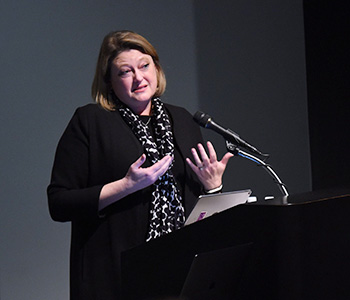 “There’s a well understood, long-standing ethical conflict with taking an organ from one person — a healthy person — to try and save someone else,” Crowley-Matoka said. “It violates one of the most basic ethical principles of medicine, and that’s to ‘do no harm.’”
“There’s a well understood, long-standing ethical conflict with taking an organ from one person — a healthy person — to try and save someone else,” Crowley-Matoka said. “It violates one of the most basic ethical principles of medicine, and that’s to ‘do no harm.’”
Crowley-Matoka cautioned that just because a medical practice is done routinely — 6,500 kidney transplants took place in the US in 2018 — doesn’t mean it’s without ethical critique. Her field work in Mexico revealed that kidney donors were often spoken of more dismissively by hospital staff when they complained about post-surgery discomfort. She also noted that robust databases exist to track the long-term outcomes of organ recipients, but no such systems are in place to monitor the welfare of donors.
“Living donors, despite receiving major abdominal surgery, despite losing what’s considered a vital organ, are never quite the real patient in the transplant context,” Crowley-Matoka said. “They’re always considered the healthy side of the donor-recipient pair.”
Self-regulating Ethics
During a Q&A session with the panelists, Robleto asked the presenters if the self-regulation of ethics guiding their work is sustainable as a broader, long-term practice.
“I think it’s less about the self and more about the greater community imposing a culture that naturally sets the boundaries,” Lucks said.
“We have to be part of the regulation,” Tullman-Ercek said. “I don’t think it should be purely self-regulated long-term, but it would be a mistake to be extract us from the process. We are intimately connected to the very next advance.”
